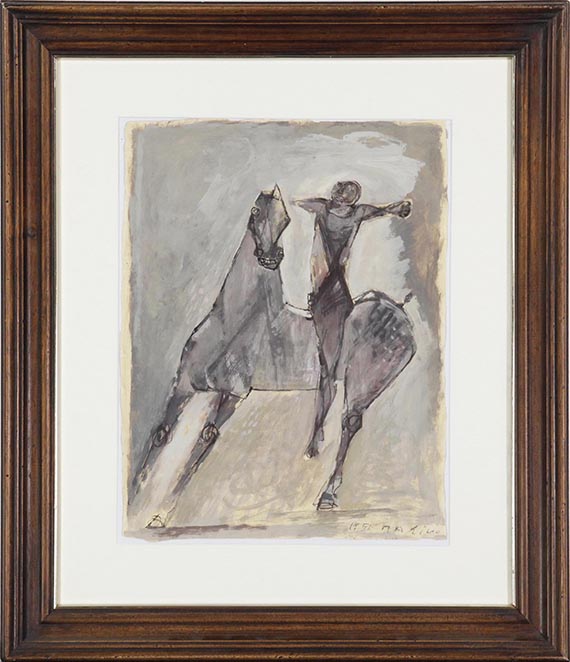118
Marino Marini
Giocoliere, 1951.
Tempera over India ink pen
Estimate:
€ 25,000 / $ 26,750 Sold:
€ 34,290 / $ 36,690 (incl. surcharge)
Giocoliere. 1951.
Tempera over India ink pen.
Signd and dated in bottom right. Signed, dated and titled on the reverse. On firm off-white paper. 45 x 34.5 cm (17.7 x 13.5 in), size of sheet. [JS].
• Depictions of horses are the most famous motifs in Marini's creation.
• Marini's graphic mastery becomes particularly obvious in the combination of clear ink contours and nuanced colors.
• Marini's horsemen pictures are allegories of the fragile balance of human existence.
• Marino Marini's works are in many important international collections, among them the Galleria d'Arte Moderna, Milan, the Peggy Guggenheim Museum, Venice, Tate Modern, London, and the National Gallery of Art, Washington.
Accompanied by a photo expertise issued by the Fondazione Marino Marini, Pistoia, on May 19, 2022. The work is registered in the artist's archive with the number 903.
PROVENANCE: Private collection Italy.
"Horse and rider must have had a strong appeal for Marini, because they dominate in his work. [.] Aside from the symbolic value, the horse appeals to the artist through certain qualities: through its appearance, the play of its muscles, its grace of movement, and ultimately through the fear it can cause when in rage or panick. The horse is the subject of excellent works of art, beginning with Palaeolithic cave paintings [.] When Marini chose the horse as his main subject, he showed a preference as old as art itself."
Patrick Waldberg and G. di San Lazzaro, Marino Marini. Leben und Werk, Frankfurt 1971, p. 12
Tempera over India ink pen.
Signd and dated in bottom right. Signed, dated and titled on the reverse. On firm off-white paper. 45 x 34.5 cm (17.7 x 13.5 in), size of sheet. [JS].
• Depictions of horses are the most famous motifs in Marini's creation.
• Marini's graphic mastery becomes particularly obvious in the combination of clear ink contours and nuanced colors.
• Marini's horsemen pictures are allegories of the fragile balance of human existence.
• Marino Marini's works are in many important international collections, among them the Galleria d'Arte Moderna, Milan, the Peggy Guggenheim Museum, Venice, Tate Modern, London, and the National Gallery of Art, Washington.
Accompanied by a photo expertise issued by the Fondazione Marino Marini, Pistoia, on May 19, 2022. The work is registered in the artist's archive with the number 903.
PROVENANCE: Private collection Italy.
"Horse and rider must have had a strong appeal for Marini, because they dominate in his work. [.] Aside from the symbolic value, the horse appeals to the artist through certain qualities: through its appearance, the play of its muscles, its grace of movement, and ultimately through the fear it can cause when in rage or panick. The horse is the subject of excellent works of art, beginning with Palaeolithic cave paintings [.] When Marini chose the horse as his main subject, he showed a preference as old as art itself."
Patrick Waldberg and G. di San Lazzaro, Marino Marini. Leben und Werk, Frankfurt 1971, p. 12
Marino Marini's work is characterized by three recurring complexes of motifs, with the motif of the horse certainly being the most famous alongside the female nudes in the form of Pomona and the acrobats or dancers. In our powerful composition in nuanced colors, this famous motif has been implemented with a particular graphic sharpness. However, it is not the grandeur of the horse, as it has been handed down in the victorious equestrian statues of famous rulers since antiquity, that appeals to Marini, it is rather the unity of horse and rider for its fragile balance and the inherent danger of failure. Hands-free and without a saddle, the rider balances on the back of the horse, which leans slightly backwards with its neck raised and its mouth open: it is not a victorious ruler, but rather an acrobat struggling for balance and control. In Marini's work, the rider threatened to fall is always a symbol of the fragile stability of our human existence. As Marini himself put it in the 1950s: "As far as I'm concerned, I no longer intend to celebrate a hero's victory. I want to express something tragic, a kind of twilight of humanity, a defeat rather than a victory." (quoted from: Kritisches Lexikon der Gegenwartskunst, Munich 2002, p. 10.). [JS]
118
Marino Marini
Giocoliere, 1951.
Tempera over India ink pen
Estimate:
€ 25,000 / $ 26,750 Sold:
€ 34,290 / $ 36,690 (incl. surcharge)




 Lot 118
Lot 118 

